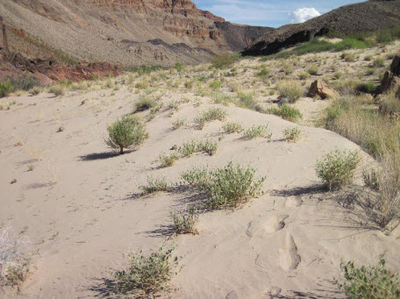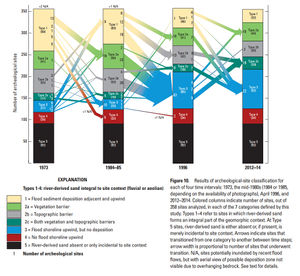Difference between revisions of "Aeolian Sand Transport"
From Glen Canyon Dam AMP
Cellsworth (Talk | contribs) |
Cellsworth (Talk | contribs) |
||
| Line 25: | Line 25: | ||
== '''Aeolian Sand Transport''' == | == '''Aeolian Sand Transport''' == | ||
| − | Sand can potentially help preserve archaeological features by direct burial and/or by mitigating gullying and other erosion. Sand can be deposited on archaeological features or within gullies via fluvial (river) or aeolian (wind) deposition. Most archaeological sites are above the highest contemporary river stage, so aeolian deposition is the most likely mechanism for preservation and/or erosion mitigation. River-sourced sand deposition is a time-dependent process, and the outer limit of that process may extend for many years after any individual HFE. Additionally, HFEs with targeted vegetation removal could produce a net sediment surplus at some sites. [https://www.usbr.gov/uc/ | + | Sand can potentially help preserve archaeological features by direct burial and/or by mitigating gullying and other erosion. Sand can be deposited on archaeological features or within gullies via fluvial (river) or aeolian (wind) deposition. Most archaeological sites are above the highest contemporary river stage, so aeolian deposition is the most likely mechanism for preservation and/or erosion mitigation. River-sourced sand deposition is a time-dependent process, and the outer limit of that process may extend for many years after any individual HFE. Additionally, HFEs with targeted vegetation removal could produce a net sediment surplus at some sites. [https://www.usbr.gov/uc/progact/amp/twg/2017-01-26-twg-meeting/AR5_Sankey.pdf] |
|}<!-- | |}<!-- | ||
| Line 44: | Line 44: | ||
|style="color:#000;"| | |style="color:#000;"| | ||
| − | [[File:AeolianClassification.jpg|center|600px | + | [[File:AeolianClassification.jpg|thumb|center|600px [https://www.usbr.gov/uc/progact/amp/twg/2015-01-20-twg-meeting/Attach_03.pdf https://www.usbr.gov/uc/progact/amp/twg/2015-01-20-twg-meeting/Attach_03.pdf] ]] |
| − | [[File:AeolianSand.jpg|center|600px | + | [[File:AeolianSand.jpg|thumb|center|600px [https://pubs.er.usgs.gov/publication/pp1825 https://pubs.er.usgs.gov/publication/pp1825] ]] |
|- | |- | ||
| Line 78: | Line 78: | ||
'''2018''' | '''2018''' | ||
| − | *[https://www.usbr.gov/uc/progact/amp/amwg/2018-08-22-amwg-meeting/ | + | *[https://www.usbr.gov/uc/progact/amp/amwg/2018-08-22-amwg-meeting/Attach_14.pdf GCMRC Science Updates PPT] |
*[https://doi.org/10.1177/0309133318795846 Kasprak et al., 2018, Quantifying and forecasting changes in the areal extent of river valley sediment in response to altered hydrology and land cover: Progress in Physical Geography: Earth and Environment] | *[https://doi.org/10.1177/0309133318795846 Kasprak et al., 2018, Quantifying and forecasting changes in the areal extent of river valley sediment in response to altered hydrology and land cover: Progress in Physical Geography: Earth and Environment] | ||
*[https://doi.org/10.1016/j.geomorph.2018.07.023 Solazzo, D., Sankey, J.B., Sankey, T.Ts., Munson, S.M., 2018. Mapping and measuring aeolian sand dunes with photogrammetry and LiDAR from unmanned aerial vehicles (UAV) and multispectral satellite imagery on the Paria Plateau, AZ, USA: Geomorphology, v. 319, p. 174-185] | *[https://doi.org/10.1016/j.geomorph.2018.07.023 Solazzo, D., Sankey, J.B., Sankey, T.Ts., Munson, S.M., 2018. Mapping and measuring aeolian sand dunes with photogrammetry and LiDAR from unmanned aerial vehicles (UAV) and multispectral satellite imagery on the Paria Plateau, AZ, USA: Geomorphology, v. 319, p. 174-185] | ||
| Line 92: | Line 92: | ||
*[[Media:Collins 2016 GCArchSitesAeolian.pdf| Collins et al. 2016. Relations between rainfall–runoff-induced erosion and aeolian deposition at archaeological sites in a semi-arid dam-controlled river corridor, Earth Surf. Process. Landforms]] | *[[Media:Collins 2016 GCArchSitesAeolian.pdf| Collins et al. 2016. Relations between rainfall–runoff-induced erosion and aeolian deposition at archaeological sites in a semi-arid dam-controlled river corridor, Earth Surf. Process. Landforms]] | ||
*[https://pubs.er.usgs.gov/publication/pp1825 East et. al. 2016. Conditions and processes affecting sand resources at archeological sites in the Colorado River corridor below Glen Canyon Dam, Arizona: U.S. Geological Survey Professional Paper] | *[https://pubs.er.usgs.gov/publication/pp1825 East et. al. 2016. Conditions and processes affecting sand resources at archeological sites in the Colorado River corridor below Glen Canyon Dam, Arizona: U.S. Geological Survey Professional Paper] | ||
| − | *[https://www.usbr.gov/uc/ | + | *[https://www.usbr.gov/uc/progact/amp/twg/2016-02-26-twg-meeting/AR04_Mueller.pdf Linkages between controlled floods, eddy sandbar dynamics, and riparian vegetation along the Colorado River in Marble Canyon, Arizona, USA ] |
'''2015''' | '''2015''' | ||
| − | *[ | + | *[https://www.usbr.gov/uc/progact/amp/twg/2015-01-20-twg-meeting/Attach_03.pdf Conditions and Processes affecting sand resources at archaeological sites] |
'''2014''' | '''2014''' | ||
| − | *[ | + | *[https://www.usbr.gov/uc/progact/amp/twg/2014-01-30-twg-meeting/AR_Sankey_Gully_remote.pdf Gully annealing by Aeolian sediment: Field and remote-sensing investigation in Glen, Marble, and Grand Canyons (Sankey)] |
'''2013''' | '''2013''' | ||
| − | *[https://www.usbr.gov/uc/ | + | *[https://www.usbr.gov/uc/progact/amp/twg/2013-01-24-twg-meeting/23_Draut.pdf Aeolian Landscapes and Archaeological Sites: 2012 Progress and New Work Plan (Project J)] |
'''2012''' | '''2012''' | ||
*[https://www.gcmrc.gov/about/ka/KA%202%20-%202-1-12/AM%20Talks/Draut%201030-1145%20Aeolian%20Landscapes.pdf Aeolian Landscapes ] | *[https://www.gcmrc.gov/about/ka/KA%202%20-%202-1-12/AM%20Talks/Draut%201030-1145%20Aeolian%20Landscapes.pdf Aeolian Landscapes ] | ||
| − | |||
| − | |||
| − | |||
'''2010''' | '''2010''' | ||
| − | *[https://www.usbr.gov/uc/ | + | *[https://www.usbr.gov/uc/progact/amp/amwg/2010-02-03-amwg-meeting/Attach_25.pdf Aeolian Reworking of Sandbars from the March 2008 Glen Canyon Dam High-Flow Experiment in Grand Canyon] |
|- | |- | ||
| Line 127: | Line 124: | ||
*'''The problem:''' Landscapes downstream from Glen Canyon Dam contain archaeological resources that are affected by fluvial (river), aeolian (wind), and hillslope (gravity and rainfall-runoff) geomorphic processes. | *'''The problem:''' Landscapes downstream from Glen Canyon Dam contain archaeological resources that are affected by fluvial (river), aeolian (wind), and hillslope (gravity and rainfall-runoff) geomorphic processes. | ||
*'''The question:''' Can Colorado River sediment enhance the preservation of river corridor archaeological resources in these landscapes through aeolian sand deposition and mitigation of gully erosion? | *'''The question:''' Can Colorado River sediment enhance the preservation of river corridor archaeological resources in these landscapes through aeolian sand deposition and mitigation of gully erosion? | ||
| − | *'''The results:''' Relatively few archeological sites are now ideally situated to receive aeolian sand supply from sandbars deposited by recent controlled floods (HFEs) from Glen Canyon Dam (decreased from 98 sites in 1973 to 32 in 2012).[https://www.usbr.gov/uc/ | + | *'''The results:''' Relatively few archeological sites are now ideally situated to receive aeolian sand supply from sandbars deposited by recent controlled floods (HFEs) from Glen Canyon Dam (decreased from 98 sites in 1973 to 32 in 2012).[https://www.usbr.gov/uc/progact/amp/twg/2017-01-26-twg-meeting/AR5_Sankey.pdf] |
|} | |} | ||
Revision as of 15:54, 23 January 2019
|
|
Aeolian Sand TransportSand can potentially help preserve archaeological features by direct burial and/or by mitigating gullying and other erosion. Sand can be deposited on archaeological features or within gullies via fluvial (river) or aeolian (wind) deposition. Most archaeological sites are above the highest contemporary river stage, so aeolian deposition is the most likely mechanism for preservation and/or erosion mitigation. River-sourced sand deposition is a time-dependent process, and the outer limit of that process may extend for many years after any individual HFE. Additionally, HFEs with targeted vegetation removal could produce a net sediment surplus at some sites. [1] |
| --- |
--- |
--- |
|---|


